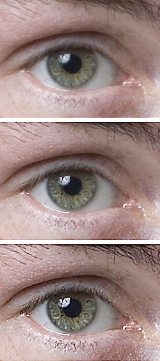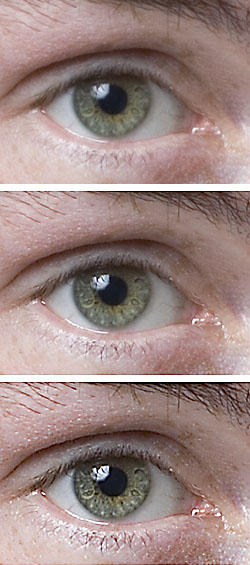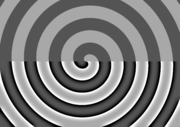
Unsharp masking
Encyclopedia

Digital image processing
Digital image processing is the use of computer algorithms to perform image processing on digital images. As a subcategory or field of digital signal processing, digital image processing has many advantages over analog image processing...
software.
The "unsharp" of the name derives from the fact that the technique uses a blurred, or "unsharp," positive to create a "mask" of the original image. The unsharped mask is then combined with the negative, creating the illusion that the resulting image is sharper than the original. From a signal-processing
Signal processing
Signal processing is an area of systems engineering, electrical engineering and applied mathematics that deals with operations on or analysis of signals, in either discrete or continuous time...
standpoint, an unsharp mask is generally a linear
Linear filter
Linear filters in the time domain process time-varying input signals to produce output signals, subject to the constraint of linearity.This results from systems composed solely of components classified as having a linear response....
or nonlinear filter that amplifies high-frequency components.
Photographic unsharp masking
The technique was first used in GermanyGermany
Germany , officially the Federal Republic of Germany , is a federal parliamentary republic in Europe. The country consists of 16 states while the capital and largest city is Berlin. Germany covers an area of 357,021 km2 and has a largely temperate seasonal climate...
in the 1930s as a way of increasing the acutance
Acutance
In photography, acutance is the edge contrast of an image. Acutance is related to the amplitude of the derivative of brightness with respect to space...
, or apparent sharpness, of photographic images.
In the photographic process, a large-format glass plate negative is contact-copied onto a low contrast film or plate to create a positive. However, the positive copy is made with the copy material in contact with the back of the original, rather than emulsion-to-emulsion, so it is blurred. After processing this blurred positive is replaced in contact with the back of the original negative. When light is passed through both negative and in-register positive (in an enlarger for example), the positive partially cancels some of the information in the negative.
Because the positive has been intentionally blurred, only the low frequency (blurred) information is cancelled. In addition, the mask effectively reduces the dynamic range of the original negative. Thus, if the resulting enlarged image is recorded on contrasty photographic paper, the partial cancellation emphasizes the high frequency (fine detail) information in the original, without loss of highlight or shadow detail. The resulting print appears sharper than one made without the unsharp mask: its acutance is increased.
In the photographic procedure, the amount of blurring can be controlled by changing the softness or hardness (from point source to fully diffuse) of the light source used for the initial unsharp mask exposure, while the strength of the effect can be controlled by changing the contrast and density (i.e., exposure and development) of the unsharp mask.
In traditional photography, unsharp masking is usually used on monochrome materials; special panchromatic
Panchromatic
Panchromatic film is a type of black-and-white photographic film that is sensitive to all wavelengths of visible light. A panchromatic film therefore produces a realistic reproduction of a scene as it appears to the human eye. Almost all modern photographic film is panchromatic, but some types are...
soft-working black and white films have been available for masking photographic colour transparencies. This has been especially useful to control the density range of a transparency intended for photomechanical reproduction.
Digital unsharp masking

Adobe Photoshop
Adobe Photoshop is a graphics editing program developed and published by Adobe Systems Incorporated.Adobe's 2003 "Creative Suite" rebranding led to Adobe Photoshop 8's renaming to Adobe Photoshop CS. Thus, Adobe Photoshop CS5 is the 12th major release of Adobe Photoshop...
and GIMP
GIMP
GIMP is a free software raster graphics editor. It is primarily employed as an image retouching and editing tool and is freely available in versions tailored for most popular operating systems including Microsoft Windows, Apple Mac OS X, and Linux.In addition to detailed image retouching and...
. The software applies a Gaussian blur
Gaussian blur
A Gaussian blur is the result of blurring an image by a Gaussian function. It is a widely used effect in graphics software, typically to reduce image noise and reduce detail...
to a copy of the original image and then compares it to the original. If the difference is greater than a user-specified threshold setting, the images are (in effect) subtracted. The threshold control constrains sharpening to image elements that differ from each other above a certain size threshold, so that sharpening of small image details, such as photographic grain
Film grain
Film grain or granularity is the random optical texture of processed photographic film due to the presence of small particles of a metallic silver, or dye clouds, developed from silver halide that have received enough photons. While film grain is a function of such particles it is not the same...
, can be suppressed.
Digital unsharp masking is a flexible and powerful way to increase sharpness, especially in scanned images. However, it is easy to create unwanted and conspicuous edge effects, or increase image noise. On the other hand, these effects can be used creatively, especially if a single channel
Channel (digital image)
Color digital images are made of pixels, and pixels are made of combinations of primary colors. A channel in this context is the grayscale image of the same size as a color image, made of just one of these primary colors. For instance, an image from a standard digital camera will have a red, green...
of an RGB
RGB color model
The RGB color model is an additive color model in which red, green, and blue light is added together in various ways to reproduce a broad array of colors...
or Lab image is sharpened. Undesired effects can be reduced by using a mask – particularly one created by edge detection – to only apply sharpening to desired regions, sometimes termed "smart sharpen".
Typically three settings control digital unsharp masking:
- Amount is listed as a percentage, and controls the magnitude of each overshoot (how much darker and how much lighter the edge borders become). This can also be thought of as how much contrast is added at the edges. It does not affect the width of the edge rims.
- Radius affects the size of the edges to be enhanced or how wide the edge rims become, so a smaller radius enhances smaller-scale detail. Higher Radius values can cause halos at the edges, a detectable faint light rim around objects. Fine detail needs a smaller Radius. Radius and Amount interact; reducing one allows more of the other.
- Threshold controls the minimum brightness change that will be sharpened or how far apart adjacent tonal values have to be before the filter does anything. This lack of action is important to prevent smooth areas from becoming speckled. The threshold setting can be used to sharpen more-pronounced edges, while leaving subtler edges untouched. Low values should sharpen more because fewer areas are excluded. Higher threshold values exclude areas of lower contrast.
Various recommendations exist as to good starting values for these parameters, and the meaning may differ between implementations. Generally a radius of 0.5 to 2 pixels and an amount of 50–150% is a reasonable start.
It is also possible to implement USM manually, by creating a separate layer to act as the mask; this can be used to help understand how USM works, or for fine customization.
Local contrast enhancement
Unsharp masking may also be used with a large radius and a small amount (such as 30–100 pixel radius and 5–20% amount) which yields increased local contrast, a technique termed local contrast enhancement. USM can increase either sharpness or (local) contrast because these are both forms of increasing differences between values, increasing slope – sharpness referring to very small-scale (high frequency) differences, and contrast referring to larger scale (low frequency) differences. More powerful techniques for improving tonality are referred to as tone mappingTone mapping
Tone mapping is a technique used in image processing and computer graphics to map one set of colors to another in order to approximate the appearance of high dynamic range images in a medium that has a more limited dynamic range...
.
Comparison with deconvolution
In image processing, deconvolutionDeconvolution
In mathematics, deconvolution is an algorithm-based process used to reverse the effects of convolution on recorded data. The concept of deconvolution is widely used in the techniques of signal processing and image processing...
is the process of approximately inverting the process that caused an image to be blurred. Specifically, unsharp masking is a simple linear image operation—a convolution by a kernel that is the Dirac delta minus a gaussian blur kernel. Deconvolution, on the other hand, is generally considered an ill-posed inverse problem
Inverse problem
An inverse problem is a general framework that is used to convert observed measurements into information about a physical object or system that we are interested in...
that is best solved by nonlinear approaches. While unsharp masking increases the apparent sharpness of an image in ignorance of the manner in which the image was acquired, deconvolution increases the apparent sharpness of an image, but based on information describing some of the likely origins of the distortions in the light path used in capturing the image; it may therefore sometimes be preferred, where the cost in preparation time and per-image computation time are offset by the increase in image clarity.
With deconvolution, "lost" image detail may be approximately recovered—although it generally is impossible to verify that any recovered detail is accurate. Statistically, some level of correspondence between the sharpened images and the actual scenes being imaged can be attained. If the scenes to be captured in the future are similar enough to validated image scenes, then one can assess the degree to which recovered detail may be accurate. The improvement to image quality is often attractive, since the same validation issues are present even for un-enhanced images.
For deconvolution to be effective, all variables in the image scene and capturing device need to be modeled, including aperture, focal length, distance to subject, lens, and media refractive indices and geometries. Applying deconvolution successfully to general-purpose camera images is usually not feasible, because the geometries of the scene are not set. However, deconvolution is applied in the real world to microscopy and astronomical imaging, where the value of gained sharpness is high, imaging devices and the relative subject positions are both well defined, and the imaging devices would cost a great deal more to optimize to improve sharpness physically. In cases where a stable, well-defined aberration is present, such as the lens defect in early Hubble Space Telescope
Hubble Space Telescope
The Hubble Space Telescope is a space telescope that was carried into orbit by a Space Shuttle in 1990 and remains in operation. A 2.4 meter aperture telescope in low Earth orbit, Hubble's four main instruments observe in the near ultraviolet, visible, and near infrared...
images, deconvolution is an especially powerful technique.
External links
- Interactive Example of Unsharp Mask
- PhotoKit Sharpener User Guide
- Sharpening 101, by thom, Aug 1, 2003
- Sharpening in Photoshop – Part I, Ron Bigelow – detailed discussion of sharpening, beginning with USM
- Primer of Blind Deconvolution A brief description of blind deconvolution (one where the blur is not known) and a list of different types of deconvolution.

